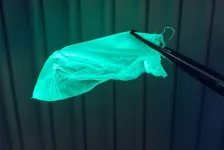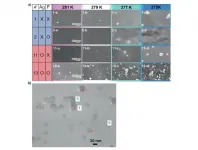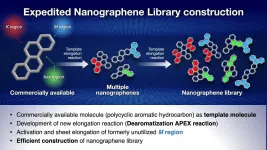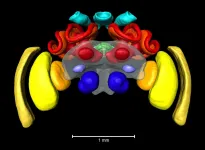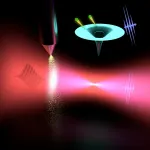Fast IR imaging-based AI identifies tumor type in lung cancer
Protein research
2021-06-28
(Press-News.org) The examined tissue does not need to be marked for this. The analysis only takes around half an hour. "This is a major step that shows that infrared imaging can be a promising methodology in future diagnostic testing and treatment prediction," says Professor Klaus Gerwert, director of PRODI. The study is published in the American Journal of Pathology on 1 July 2021.
Treatment decision by means of a genetic mutation analysis
Lung tumours are divided into various types, such as small cell lung cancer, adenocarcinoma and squamous cell carcinoma. Many rare tumour types and sub-types also exist. This diversity hampers reliable rapid diagnostic methods in everyday clinical practice. In addition to histological typing, the tumour samples also need to be comprehensively examined for certain changes at a DNA level. "Detecting one of these mutations is important key information that influences both the prognosis and further therapeutic decisions," says co-author Professor Reinhard Büttner, head of the Institute of General Pathology and Pathological Anatomy at University Hospital Cologne.
Patients with lung cancer clearly benefit when the driver mutations have previously been characterised: for instance, tumours with activating mutations in the EGFR (epidermal growth factor) gene often respond well to tyrosine kinase inhibitors, whereas non-EGFR-mutated tumours or tumours with other mutations, such as KRAS, do not respond at all to this medication. The differential diagnosis of lung cancer previously took place with immunohistochemical staining of tissue samples and a subsequent extensive genetic analysis to determine the mutation.
Fast and reliable measuring technique
The potential of infrared imaging, IR imaging for short, as a diagnostic tool to classify tissue, called label-free digital pathology, was already shown by the group led by Klaus Gerwert in previous studies. The procedure identifies cancerous tissue without prior staining or other markings and functions automatically with the aid of artificial intelligence (AI). In contrast to the methods used to determine tumour shape and mutations in tumour tissue in everyday clinical practice, which can sometimes take several days, the new procedure only takes around half an hour. In these 30 minutes, it is not only possible to ascertain whether the tissue sample contains tumour cells, but also what type of tumour it is and whether it contains a certain mutation.
Infrared spectroscopy makes genetic mutations visible
The Bochum researchers were able to verify the procedure on samples from over 200 lung cancer patients in their work. When identifying mutations, they concentrated on by far the most common lung tumour, adenocarcinoma, which accounts for over 50 per cent of tumours. Its most common genetic mutations can be determined with a sensitivity and specificity of 95 per cent compared to laborious genetic analysis. "For the first time, we were able to identify spectral markers that allow for a spatially resolved distinction between various molecular conditions in lung tumours," explains Nina Goertzen from PRODI. A single infrared spectroscopic measurement offers information about the sample which would otherwise require several time-consuming procedures.
A further step towards personalised medicine
The results once again confirm the potential of label-free digital pathology for clinical use. "To further increase reliability and promote a translation of the method as a new diagnostic tool, studies with larger patient numbers adapted to clinical needs and external testing in everyday clinical practice are required," says Dr. Frederik Großerüschkamp, IR imaging project manager. "In order to translate IR imaging into everyday clinical practice, it is crucial to shorten the measuring time, ensure simple and reliable operation of the measuring instruments, and provide answers to questions that are important and helpful both clinically and for the patients."
INFORMATION:
ELSE PRESS RELEASES FROM THIS DATE:
2021-06-28
There are spiders that eat snakes. Observations of snake-eating spiders have been reported around the world. Two researchers from Basel and the US consolidated and analyzed over 300 reports of this unusual predation strategy.
Spiders are primarily insectivores, but they occasionally expand their menu by catching and eating small snakes. Dr. Martin Nyffeler, arachnologist at the University of Basel, and American herpetologist Professor Whitfield Gibbons of the University of Georgia, USA, got to the bottom of this phenomenon in a meta-analysis. Their findings from ...
2021-06-28
Announcing a new article publication for BIO Integration journal. In this article the authors Chunxiong Zheng, Mingqiang Li and Jianxun Ding from Sun Yat-sen University, Guangzhou, China and Changchun Institute of Applied Chemistry, Changchun, China discuss the challenges and opportunities of nanomedicines in clinical translation.
Researchers are rapidly gaining a much deeper understanding of the challenges and opportunities of nanomedicines allowing for improvements in disease treatment and improved patient survival.
Deep exploration of the connections between preclinical and clinical ...
2021-06-28
In March 2020, daily life in the United States changed in an instant as the country locked down to deal with the initial wave of the COVID-19 pandemic. New research reveals how residents in one community returned to their routines as the restrictions lifted, according to a team of Penn State scientists.
"We used sound signals captured by underground fiber-optic sensors to understand how COVID measures impacted human activities," said Junzhu Shen, a graduate student in geosciences at Penn State. "These sensors provide very accurate, high-resolution data that can help us understand what's happening in our communities."
The scientists analyzed sound data recorded from March through June 2020 in and around the Penn State University Park campus and State College, ...
2021-06-28
Researchers have developed smart wound dressings with built-in nanosensors that glow to alert patients when a wound is not healing properly.
The multifunctional, antimicrobial dressings feature fluorescent sensors that glow brightly under UV light if infection starts to set in and can be used to monitor healing progress.
The smart dressings, developed by a team of scientists and engineers at RMIT University in Melbourne, Australia, harness the powerful antibacterial and antifungal properties of magnesium hydroxide.
They are cheaper to produce than silver-based dressings but equally as effective in fighting bacteria and fungi, with their antimicrobial power lasting up to a week.
Project leader Dr Vi Khanh Truong said the development of cost-effective antimicrobial ...
2021-06-28
Results of this technique, known as transfer learning, achieved a 99.24 per cent success rate when detecting COVID-19 in chest x-rays.
The study tackles one of the biggest challenges in image recognition machine learning: algorithms needing huge quantities of data, in this case images, to be able to recognise certain attributes accurately.
ECU School of Science researcher END ...
2021-06-28
Osaka, Japan - Scientists at Osaka University, Panasonic Corporation, and Waseda University used scanning electron microscopy (SEM) and X-ray absorption spectroscopy to determine which additives induce crystallization in supercooled aqueous solutions. This work may lead to the development of new energy storage materials based on latent heat.
If you put a bottle of water into the freezer, you will expect to pull out a solid cylinder of ice after a few hours. However, if the water has very few impurities and left undisturbed, it may not be frozen, and instead remain as a supercooled liquid. Be careful, because this state is very unstable, and the water will crystallize quickly if shaken or impurities are added - as many YouTube videos will attest. ...
2021-06-28
A group of researchers at Nagoya University, Japan, have developed a new method for quickly and efficiently synthesizing nanographenes, a type of nanocarbon with great potential as a next generation material.
Nanographenes are the part structures of graphene, which is a sheet of carbon atoms around 3 nanometers thick with particular potential for use in semiconductor development, having electron mobility several hundred times better than current generation materials. Graphene was first isolated in 2004, a discovery which received the 2010 Nobel Prize in physics, making it a very new material which is currently the subject of a great deal of research.
With ...
2021-06-28
The buff-tailed bumblebee Bombus terrestris is one of the most common bumblebee species in Europe. It is not only active in nature as a pollinator - humans also use it in greenhouses and foil tunnels to get good harvests of tomatoes or strawberries.
The buff-tailed bumblebee is also used in science: "Basic research is increasingly using it as a model organism to analyse learning and memory, the visual system, flight control and navigation abilities," says Dr. Keram Pfeiffer, Professor of neurobiology at the Biocenter of Julius-Maximilians-Universität (JMU) Würzburg in Bavaria, Germany.
Pfeiffer investigates the neuronal ...
2021-06-28
A RMIT-led international collaboration published this week has achieved record-high electron doping in a layered ferromagnet, causing magnetic phase transition with significant promise for future electronics
Control of magnetism (or spin directions) by electric voltage is vital for developing future, low-energy high-speed nano-electronic and spintronic devices, such as spin-orbit torque devices and spin field-effect transistors.
Ultra-high-charge, doping-induced magnetic phase transition in a layered ferromagnet allows promising applications in antiferromagnetic spintronic devices.
The FLEET collaboration of researchers at RMIT, UNSW, the University of Wollongong and FLEET partner ...
2021-06-28
The invention of the laser has opened the era of nonlinear optics, which today plays an important role in many scientific, industrial and medical applications. These applications all benefit from the availability of compact lasers in the visible range of the electromagnetic spectrum. The situation is different at XUV wavelengths, where very large facilities (so called free-electron lasers) have been built to generate intense XUV pulses. One example of these is FLASH in Hamburg that extends over several hundred meters. Smaller intense XUV sources based on HHG have also been developed. However, these sources still have a footprint of tens of meters, and have so far only been demonstrated at a few universities and research institutes worldwide. ...
LAST 30 PRESS RELEASES:
[Press-News.org] Fast IR imaging-based AI identifies tumor type in lung cancer
Protein research


